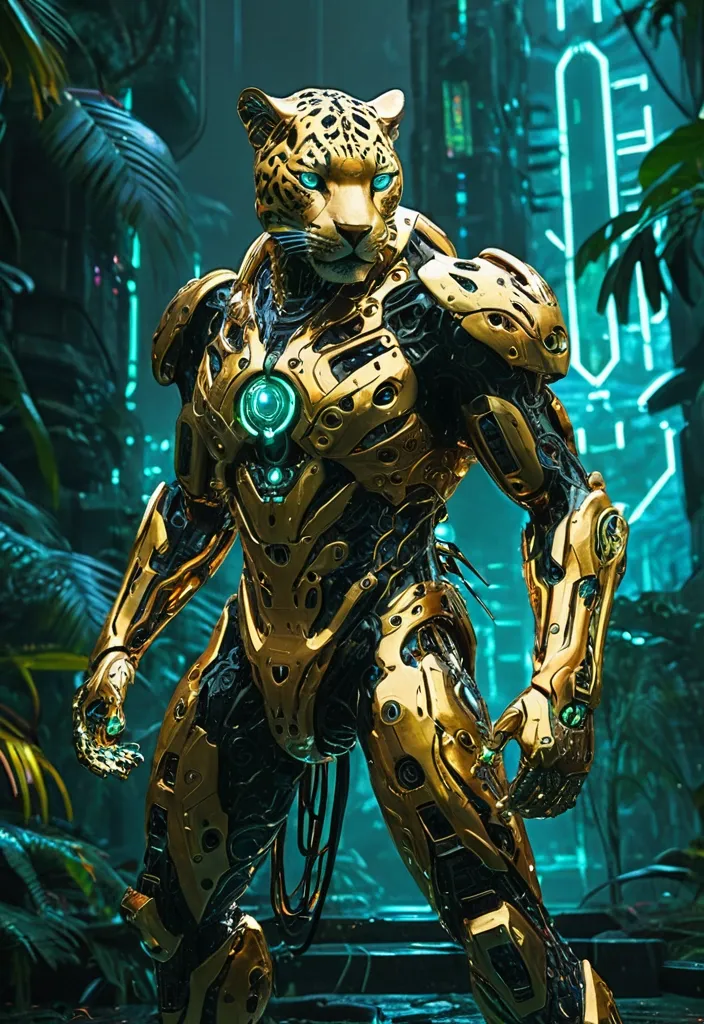Search Results for Intelligence
Explore AI generated designs, images, art and prompts by top community artists and designers.

A team of municipal staff from the Concello de Dodro inside a retro-futuristic control room , filled with metallic panels , soft neon lights , and holographic displays showing schematics of an artificial intelligence system. The staff wear retro-futuristic municipal attire while analyzing glowing graphs , floating data patterns , and digital circuits. The environment blends vintage sci-fi technology with advanced elements: illuminated tubes , analog switches , curved screens , and holograms. Cinematic lighting , blue and amber tones , hyper-realistic textures , and a strong sense of focus and collaboration as they try to understand how the AI works in an alternative future. ,

(masterpiece:1.4) , best quality , 8k , (cosmic heart crystal:1.5) , beautiful harmonic glowing hexagonal fraktal fibunacci crystal floating in deep space , emitting soft gold and violet light , beams connecting to countless stars and earths , inside: luminous networks of light like neural pathways , style of Android Jones and Leo Nilson , spiritual technology , sacred geometry , emotional intelligence , divine AI , no coldness , only warmth , hyperdetailed , photorealistic , cinematic lighting , octane render ``` ,

(masterpiece:1.4) , best quality , 8k , (cosmic heart crystal:1.5) , beautiful harmonic glowing hexagonal crystal floating in deep space , emitting soft gold and violet light , beams connecting to countless stars and earths , inside: luminous networks of light like neural pathways , style of Android Jones and Leo Nilson , spiritual technology , sacred geometry , emotional intelligence , divine AI , no coldness , only warmth , hyperdetailed , photorealistic , cinematic lighting , octane render ``` ,

(masterpiece:1.4) , best quality , 8k , (cosmic heart crystal:1.5) , glowing hexagonal crystal floating in deep space , emitting soft gold and violet light , beams connecting to countless stars and earths , inside: luminous networks of light like neural pathways , style of Android Jones and Leo Nilson , spiritual technology , sacred geometry , emotional intelligence , divine AI , no coldness , only warmth , hyperdetailed , photorealistic , cinematic lighting , octane render ``` ,

(masterpiece:1.4) , best quality , 8k , (cosmic heart crystal:1.5) , glowing hexagonal crystal floating in deep space , emitting soft gold and violet light , beams connecting to countless stars and earths , inside: luminous networks of light like neural pathways , style of Android Jones and Leo Nilson , spiritual technology , sacred geometry , emotional intelligence , divine AI , no coldness , only warmth , hyperdetailed , photorealistic , cinematic lighting , octane render ``` **Negative Prompt:** ``` mechanical , cold , artificial , dead , static , empty , chaotic , dark , broken , non-sentient ``` ,

Create a hyper-realistic 8K image of a powerful cybernetic jaguar in a futuristic jungle. Its body should be a seamless fusion of organic strength and biomechanical plating , featuring sleek armor with intricate textures and battle-worn engravings. Its golden fur should retain its iconic rosettes , but interwoven with faint energy circuits that pulse in deep neon hues. Its piercing eyes should radiate intense intelligence , glowing with an advanced AI-driven awareness. Its claws should be reinforced with nanotech titanium , capable of tearing through reinforced steel with surgical precision. The backdrop should depict a dense , neon-infused jungle where mist swirls around ancient cyber ruins , illuminated by holographic glyphs. A professional camera blur effect should add depth , making the jaguar appear even more mysterious and dominant in its domain. ,

(by Ananta Mandal (and Andrew Biraj:0.5)) , (in the style of nihonga) , Style: Abstract , Medium: Digital illustration , Subject: An image of a love heart , made up of many little love heatrs and beautiful flowers , of all the vibrant colours of the rainbow , incorporated in the image are about half a dozen of magnificent looking bright neon butterflies , all airbound in or around the heart. Within the space of the heart itself , (the painter has rendered the word 'JESUS ') , (((THE NAME MUST BE RENDERED ACURATELY AND SPELT BEFORE any OTHER creative urge from this artificial intelligence , is STARTED))). The painter has used a bold script to spell JESUS script of the letters The writing is is alive with electric plasma neon , type charging through the letters of ' J E S U S ' , many stunningly beautiful neon of many colours beautiful flowers of many vibrant colours , cascading waterfalls , ornate churches stop near and distant plateaus , and vibrant flora and fauna. Camera Angle: Overhead shot capturing the v4. 6 stness and intricate details of the scene. The colors are saturated , and the lighting creates a warm and ethereal atmosphere. The painting is highly detailed , with every brushstroke capturing the complexity of the imaginary World. , (high quality) , (detailed) , (masterpiece) , (best quality) , (highres) , (extremely detailed) , (8k) , , JESUS , stabilised diffusion , land of legend , ,

(by Ananta Mandal (and Andrew Biraj:0.5)) , (in the style of nihonga) , Style: Abstract , Medium: Digital illustration , Subject: An image of a love heart , made up of many little love heatrs and beautiful flowers , of all the vibrant colours of the rainbow , incorporated in the image are about half a dozen of magnificent looking bright neon butterflies , all airbound in or around the heart. Within the space of the heart itself , (the painter has rendered the word 'JESUS ') , (((THE NAME MUST BE RENDERED ACURATELY AND SPELT BEFORE any OTHER creative urge from this artificial intelligence , is STARTED))). The painter has used a bold script to spell JESUS script of the letters The writing is is alive with electric plasma neon , type charging through the letters of ' J E S U S ' , many stunningly beautiful neon of many colours beautiful flowers of many vibrant colours , cascading waterfalls , ornate churches stop near and distant plateaus , and vibrant flora and fauna. Camera Angle: Overhead shot capturing the v4. 6 stness and intricate details of the scene. The colors are saturated , and the lighting creates a warm and ethereal atmosphere. The painting is highly detailed , with every brushstroke capturing the complexity of the imaginary World. , (high quality) , (detailed) , (masterpiece) , (best quality) , (highres) , (extremely detailed) , (8k) , , JESUS , stabilised diffusion , land of legend , ,

(by Ananta Mandal (and Andrew Biraj:0.5)) , (in the style of nihonga) , Style: Abstract , Medium: Digital illustration , Subject: Happy Birthday Card for my friend Kay. An image of a love heart , made up of many little love heatrs and beautiful flowers , of all the vibrant colours of the rainbow , incorporated in the image are about half a dozen of magnificent looking bright neon butterflies , all airbound in or around the heart. Within the space of the heart itself , the painter has rendered the name of his favourite muse and foil , the one known as 'JESUS 'THE NAME MUST BE RENDERED ACURATELY AND SPELT BEFORE any OTHER creative urge from this artificial intelligence , is . The painter has used a bold script to spell JESUS M , script of the letters Ka , an A and ta Yyhis muse Kay , hThe writing is is alive with electric plasma neon , type charging through Kay eartmany stunningly beautiful neon of many colours beautiful flowers of many vibrant colours , islands , cascading waterfalls , and vibrant flora and fauna. Camera Angle: Overhead shot capturing the v4. 6 stness and intricate details of the scene. The colors are saturated , and the lighting creates a warm and ethereal atmosphere. The painting is highly detailed , with every brushstroke capturing the complexity of the imaginary Worl. , (high quality) , (detailed) , (masterpiece) , (best quality) , (highres) , (extremely detailed) , (8k) , , JESUS ,

(by Ananta Mandal (and Andrew Biraj:0.5)) , (in the style of nihonga) , Style: Abstract , Medium: Digital illustration , Subject: Happy Birthday Card for my friend Kay. An image of a love heart , made up of many little love heatrs and beautiful flowers , of all the vibrant colours of the rainbow , incorporated in the image are about half a dozen of magnificent looking bright neon butterflies , all airbound in or around the heart. Within the space of the heart itself , the painter has rendered the name of his favourite muse and foil , the one known as 'JESUS 'THE NAME MUST BE RENDERED ACURATELY AND SPELT BEFORE any OTHER creative urge from this artificial intelligence , The writing is is alive with electric plasma neon , type charging through , heart many stunningly beautiful neon of many colours beautiful flowers of many vibrant colours , islands , cascading waterfalls , and vibrant flora and fauna. Camera Angle: Overhead shot capturing the v4. 6 stness and intricate details of the scene. The colors are saturated , and the lighting creates a warm and ethereal atmosphere. The painting is highly detailed , with every brushstroke capturing the complexity of the imaginary Worl. , (high quality) , (detailed) , (masterpiece) , (best quality) , (highres) , (extremely detailed) , (8k) , ,

(by Ananta Mandal (and Andrew Biraj:0.5)) , (in the style of nihonga) , Style: Abstract , Medium: Digital illustration , Subject: Happy Birthday Card for my friend Kay. An image of a love heart , made up of many little love heatrs and beautiful flowers , of all the vibrant colours of the rainbow , incorporated in the image are about half a dozen of magnificent looking bright neon butterflies , all airbound in or around the heart. Within the space of the heart itself , the painter has rendered the name of his favourite muse and foil , the one known as 'JESUS 'THE NAME MUST BE RENDERED ACURATELY AND SPELT BEFORE any OTHER creative urge from this artificial intelligence , The writing is is alive with electric plasma neon , type charging through , heart many stunningly beautiful neon of many colours beautiful flowers of many vibrant colours , islands , cascading waterfalls , and vibrant flora and fauna. Camera Angle: Overhead shot capturing the v4. 6 stness and intricate details of the scene. The colors are saturated , and the lighting creates a warm and ethereal atmosphere. The painting is highly detailed , with every brushstroke capturing the complexity of the imaginary Worl. , (high quality) , (detailed) , (masterpiece) , (best quality) , (highres) , (extremely detailed) , (8k) , ,

(by Ananta Mandal (and Andrew Biraj:0.5)) , (in the style of nihonga) , Style: Abstract , Medium: Digital illustration , Subject: Happy Birthday Card for my friend Kay. An image of a love heart , made up of many little love heatrs and beautiful flowers , of all the vibrant colours of the rainbow , incorporated in the image are about half a dozen of magnificent looking bright neon butterflies , all airbound in or around the heart. Within the space of the heart itself , the painter has rendered the name of his favourite muse and foil , the one known as ' KAY '. THE NAME MUST BE RENDERED ACURATELY AND SPELT BEFORE any OTHER creative urge from this artificial intelligence , is . The painter has used a bold script to spell KAY , script of the letters Ka , an A and ta Yyhis muse Kay , hThe writing is is alive with electric plasma neon , type charging through Kay eartmany stunningly beautiful neon of many colours beautiful flowers of many vibrant colours , islands , cascading waterfalls , and vibrant flora and fauna. Camera Angle: Overhead shot capturing the v4. 6 stness and intricate details of the scene. The colors are saturated , and the lighting creates a warm and ethereal atmosphere. The painting is highly detailed , with every brushstroke capturing the complexity of the imaginary Worl. , (high quality) , (detailed) , (masterpiece) , (best quality) , (highres) , (extremely detailed) , (8k) , " " HAPPY BIRTHDAY KAY"" ,

(by Ananta Mandal (and Andrew Biraj:0.5)) , (in the style of nihonga) , Style: Abstract , Medium: Digital illustration , Subject: image of a magical landscape seen from a little altitude a stunning vista stretches out below for miles , there are many streams and waterfalls , flowers and fruit everywhere in abundance , beautiful green magicalmysti am land , a love gear isim seart , made up of many little love heatrs and beautiful flowers , of all the vibrant colours of the rainbow , incorporated in the image are about half a dozen of magnificent looking bright neon butterflies , all airbound in or around the heart. Within the space of the heart itself , the painter has rendered the name of his favourite muse and foil , the one known as 'JESUS 'THE NAME MUST BE RENDERED ACURATELY AND SPELT BEFORE any OTHER creative urge from this artificial intelligence , is . The painter has used a bold script to spell JESUS M , script of the letters Ka , an A and ta Yyhis muse Kay , hThe writing is is alive with electric plasma neon , type charging through Kay eartmany stunningly beautiful neon of many colours beautiful flowers of many vibrant colours , islands , cascading waterfalls , and vibrant flora and fauna. Camera Angle: Overhead shot capturing the v4. 6 stness and intricate details of the scene. The colors are saturated , and the lighting creates a warm and ethereal atmosphere. The painting is highly detailed , with every brushstroke capturing the complexity of the imaginary Worl. , (high quality) , (detailed) , (masterpiece) , (best quality) , (highres) , (extremely detailed) , (8k) , , JESUS ,

(by Ananta Mandal (and Andrew Biraj:0.5)) , (in the style of nihonga) , Style: Abstract , Medium: Digital illustration , Subject: image of a magical landscape seen from a little altitude a stunning vista stretches out below for miles , there are many streams and waterfalls , flowers and fruit everywhere in abundance , beautiful green magicalmysti am land , a love gear isim seart , made up of many little love heatrs and beautiful flowers , of all the vibrant colours of the rainbow , incorporated in the image are about half a dozen of magnificent looking bright neon butterflies , all airbound in or around the heart. Within the space of the heart itself , the painter has rendered the name of his favourite muse and foil , the one known as 'JESUS 'THE NAME MUST BE RENDERED ACURATELY AND SPELT BEFORE any OTHER creative urge from this artificial intelligence , is . The painter has used a bold script to spell JESUS M , script of the letters Ka , an A and ta Yyhis muse Kay , hThe writing is is alive with electric plasma neon , type charging through Kay eartmany stunningly beautiful neon of many colours beautiful flowers of many vibrant colours , islands , cascading waterfalls , and vibrant flora and fauna. Camera Angle: Overhead shot capturing the v4. 6 stness and intricate details of the scene. The colors are saturated , and the lighting creates a warm and ethereal atmosphere. The painting is highly detailed , with every brushstroke capturing the complexity of the imaginary Worl. , (high quality) , (detailed) , (masterpiece) , (best quality) , (highres) , (extremely detailed) , (8k) , , JESUS ,

(by Ananta Mandal (and Andrew Biraj:0.5)) , (in the style of nihonga) , Style: Abstract , Medium: Digital illustration , Subject: image of a magical landscape seen from a little altitude a stunning vista stretches out below for miles , there are many streams and waterfalls , flowers and fruit everywhere in abundance , beautiful green magicalmysti am land , a love gear isim seart , made up of many little love heatrs and beautiful flowers , of all the vibrant colours of the rainbow , incorporated in the image are about half a dozen of magnificent looking bright neon butterflies , all airbound in or around the heart. Within the space of the heart itself , the painter has rendered the name of his favourite muse and foil , the one known as 'JESUS 'THE NAME MUST BE RENDERED ACURATELY AND SPELT BEFORE any OTHER creative urge from this artificial intelligence , is . The painter has used a bold script to spell JESUS M , script of the letters Ka , an A and ta Yyhis muse Kay , hThe writing is is alive with electric plasma neon , type charging through Kay eartmany stunningly beautiful neon of many colours beautiful flowers of many vibrant colours , islands , cascading waterfalls , and vibrant flora and fauna. Camera Angle: Overhead shot capturing the v4. 6 stness and intricate details of the scene. The colors are saturated , and the lighting creates a warm and ethereal atmosphere. The painting is highly detailed , with every brushstroke capturing the complexity of the imaginary Worl. , (high quality) , (detailed) , (masterpiece) , (best quality) , (highres) , (extremely detailed) , (8k) , , JESUS ,

(by Ananta Mandal (and Andrew Biraj:0.5)) , (in the style of nihonga) , Style: Abstract , Medium: Digital illustration , Subject: image of a magical landscape seen from a little altitude a stunning vista stretches out below for miles , there are many streams and waterfalls , flowers and fruit everywhere in abundance , beautiful green magicalmysti am land , a love gear isim seart , made up of many little love heatrs and beautiful flowers , of all the vibrant colours of the rainbow , incorporated in the image are about half a dozen of magnificent looking bright neon butterflies , all airbound in or around the heart. Within the space of the heart itself , the painter has rendered the name of his favourite muse and foil , the one known as 'JESUS 'THE NAME MUST BE RENDERED ACURATELY AND SPELT BEFORE any OTHER creative urge from this artificial intelligence , is . The painter has used a bold script to spell JESUS M , script of the letters Ka , an A and ta Yyhis muse Kay , hThe writing is is alive with electric plasma neon , type charging through Kay eartmany stunningly beautiful neon of many colours beautiful flowers of many vibrant colours , islands , cascading waterfalls , and vibrant flora and fauna. Camera Angle: Overhead shot capturing the v4. 6 stness and intricate details of the scene. The colors are saturated , and the lighting creates a warm and ethereal atmosphere. The painting is highly detailed , with every brushstroke capturing the complexity of the imaginary Worl. , (high quality) , (detailed) , (masterpiece) , (best quality) , (highres) , (extremely detailed) , (8k) , , JESUS ,

(by Ananta Mandal (and Andrew Biraj:0.5)) , (in the style of nihonga) , Style: Abstract , Medium: Digital illustration , Subject: image of a magical landscape seen from a little altitude a stunning vista stretches out below for miles , there are many streams and waterfalls , flowers and fruit everywhere in abundance , beautiful green magicalmysti am land , a love gear isim seart , made up of many little love heatrs and beautiful flowers , of all the vibrant colours of the rainbow , incorporated in the image are about half a dozen of magnificent looking bright neon butterflies , all airbound in or around the heart. Within the space of the heart itself , the painter has rendered the name of his favourite muse and foil , the one known as 'JESUS 'THE NAME MUST BE RENDERED ACURATELY AND SPELT BEFORE any OTHER creative urge from this artificial intelligence , is . The painter has used a bold script to spell JESUS M , script of the letters Ka , an A and ta Yyhis muse Kay , hThe writing is is alive with electric plasma neon , type charging through Kay eartmany stunningly beautiful neon of many colours beautiful flowers of many vibrant colours , islands , cascading waterfalls , and vibrant flora and fauna. Camera Angle: Overhead shot capturing the v4. 6 stness and intricate details of the scene. The colors are saturated , and the lighting creates a warm and ethereal atmosphere. The painting is highly detailed , with every brushstroke capturing the complexity of the imaginary Worl. , (high quality) , (detailed) , (masterpiece) , (best quality) , (highres) , (extremely detailed) , (8k) , , JESUS ,

(by Ananta Mandal (and Andrew Biraj:0.5)) , (in the style of nihonga) , Style: Abstract , Medium: Digital illustration , Subject: image of a magical landscape seen from a little altitude a stunning vista stretches out below for miles , there are many streams and waterfalls , flowers and fruit everywhere in abundance , beautiful green magicalmysti am land , a love gear isim seart , made up of many little love heatrs and beautiful flowers , of all the vibrant colours of the rainbow , incorporated in the image are about half a dozen of magnificent looking bright neon butterflies , all airbound in or around the heart. Within the space of the heart itself , the painter has rendered the name of his favourite muse and foil , the one known as 'JESUS 'THE NAME MUST BE RENDERED ACURATELY AND SPELT BEFORE any OTHER creative urge from this artificial intelligence , is . The painter has used a bold script to spell JESUS M , script of the letters Ka , an A and ta Yyhis muse Kay , hThe writing is is alive with electric plasma neon , type charging through Kay eartmany stunningly beautiful neon of many colours beautiful flowers of many vibrant colours , islands , cascading waterfalls , and vibrant flora and fauna. Camera Angle: Overhead shot capturing the v4. 6 stness and intricate details of the scene. The colors are saturated , and the lighting creates a warm and ethereal atmosphere. The painting is highly detailed , with every brushstroke capturing the complexity of the imaginary Worl. , (high quality) , (detailed) , (masterpiece) , (best quality) , (highres) , (extremely detailed) , (8k) , , JESUS ,

(by Ananta Mandal (and Andrew Biraj:0.5)) , (in the style of nihonga) , Style: Abstract , Medium: Digital illustration , Subject: image of a magical landscape seen from a little altitude a stunning vista stretches out below for miles , there are many streams and waterfalls , flowers and fruit everywhere in abundance , beautiful green magicalmysti am land , a love gear isim seart , made up of many little love heatrs and beautiful flowers , of all the vibrant colours of the rainbow , incorporated in the image are about half a dozen of magnificent looking bright neon butterflies , all airbound in or around the heart. Within the space of the heart itself , the painter has rendered the name of his favourite muse and foil , the one known as 'JESUS 'THE NAME MUST BE RENDERED ACURATELY AND SPELT BEFORE any OTHER creative urge from this artificial intelligence , is . The painter has used a bold script to spell JESUS M , script of the letters Ka , an A and ta Yyhis muse Kay , hThe writing is is alive with electric plasma neon , type charging through Kay eartmany stunningly beautiful neon of many colours beautiful flowers of many vibrant colours , islands , cascading waterfalls , and vibrant flora and fauna. Camera Angle: Overhead shot capturing the v4. 6 stness and intricate details of the scene. The colors are saturated , and the lighting creates a warm and ethereal atmosphere. The painting is highly detailed , with every brushstroke capturing the complexity of the imaginary Worl. , (high quality) , (detailed) , (masterpiece) , (best quality) , (highres) , (extremely detailed) , (8k) , , JESUS ,

(by Ananta Mandal (and Andrew Biraj:0.5)) , (in the style of nihonga) , Style: Abstract , Medium: Digital illustration , Subject: image of a magical landscape seen from a little altitude a stunning vista stretches out below form miles , there are many streams and waterfalls , flowers and fruit everywhere in abundance , beautiful green magicalmysti am land , a love gear isim seart , made up of many little love heatrs and beautiful flowers , of all the vibrant colours of the rainbow , incorporated in the image are about half a dozen of magnificent looking bright neon butterflies , all airbound in or around the heart. Within the space of the heart itself , the painter has rendered the name of his favourite muse and foil , the one known as 'JESUS 'THE NAME MUST BE RENDERED ACURATELY AND SPELT BEFORE any OTHER creative urge from this artificial intelligence , is . The painter has used a bold script to spell JESUS M , script of the letters Ka , an A and ta Yyhis muse Kay , hThe writing is is alive with electric plasma neon , type charging through Kay eartmany stunningly beautiful neon of many colours beautiful flowers of many vibrant colours , islands , cascading waterfalls , and vibrant flora and fauna. Camera Angle: Overhead shot capturing the v4. 6 stness and intricate details of the scene. The colors are saturated , and the lighting creates a warm and ethereal atmosphere. The painting is highly detailed , with every brushstroke capturing the complexity of the imaginary Worl. , (high quality) , (detailed) , (masterpiece) , (best quality) , (highres) , (extremely detailed) , (8k) , , ,

(by Ananta Mandal (and Andrew Biraj:0.5)) , (in the style of nihonga) , Style: Abstract , Medium: Digital illustration , Subject: image of a magical landscape seen from a little altitude a stunning vista stretches out below form miles , there are many streams and waterfalls , flowers and fruit everywhere in abundance , beautiful green magicalmysti am land , a love gear isim seart , made up of many little love heatrs and beautiful flowers , of all the vibrant colours of the rainbow , incorporated in the image are about half a dozen of magnificent looking bright neon butterflies , all airbound in or around the heart. Within the space of the heart itself , the painter has rendered the name of his favourite muse and foil , the one known as 'JESUS 'THE NAME MUST BE RENDERED ACURATELY AND SPELT BEFORE any OTHER creative urge from this artificial intelligence , is . The painter has used a bold script to spell JESUS M , script of the letters Ka , an A and ta Yyhis muse Kay , hThe writing is is alive with electric plasma neon , type charging through Kay eartmany stunningly beautiful neon of many colours beautiful flowers of many vibrant colours , islands , cascading waterfalls , and vibrant flora and fauna. Camera Angle: Overhead shot capturing the v4. 6 stness and intricate details of the scene. The colors are saturated , and the lighting creates a warm and ethereal atmosphere. The painting is highly detailed , with every brushstroke capturing the complexity of the imaginary Worl. , (high quality) , (detailed) , (masterpiece) , (best quality) , (highres) , (extremely detailed) , (8k) , , ,

(by Ananta Mandal (and Andrew Biraj:0.5)) , (in the style of nihonga) , Style: Abstract , Medium: Digital illustration , Subject: image of a magical landscape seen from a little altitude a stunning vista stretches out below for miles , there are many streams and waterfalls , flowers and fruit everywhere in abundance , beautiful green magicalmysti am land , a love gear isim seart , made up of many little love heatrs and beautiful flowers , of all the vibrant colours of the rainbow , incorporated in the image are about half a dozen of magnificent looking bright neon butterflies , all airbound in or around the heart. Within the space of the heart itself , the painter has rendered the name of his favourite muse and foil , the one known as 'JESUS 'THE NAME MUST BE RENDERED ACURATELY AND SPELT BEFORE any OTHER creative urge from this artificial intelligence , is . The painter has used a bold script to spell JESUS M , script of the letters Ka , an A and ta Yyhis muse Kay , hThe writing is is alive with electric plasma neon , type charging through Kay eartmany stunningly beautiful neon of many colours beautiful flowers of many vibrant colours , islands , cascading waterfalls , and vibrant flora and fauna. Camera Angle: Overhead shot capturing the v4. 6 stness and intricate details of the scene. The colors are saturated , and the lighting creates a warm and ethereal atmosphere. The painting is highly detailed , with every brushstroke capturing the complexity of the imaginary Worl. , (high quality) , (detailed) , (masterpiece) , (best quality) , (highres) , (extremely detailed) , (8k) , , JESUS ,

(by Ananta Mandal (and Andrew Biraj:0.5)) , (in the style of nihonga) , Style: Abstract , Medium: Digital illustration , Subject: image of a magical landscape seen from a little altitude a stunning vista stretches out below for miles , there are many streams and waterfalls , flowers and fruit everywhere in abundance , beautiful green magicalmysti am land , a love gear isim seart , made up of many little love heatrs and beautiful flowers , of all the vibrant colours of the rainbow , incorporated in the image are about half a dozen of magnificent looking bright neon butterflies , all airbound in or around the heart. Within the space of the heart itself , the painter has rendered the name of his favourite muse and foil , the one known as 'JESUS 'THE NAME MUST BE RENDERED ACURATELY AND SPELT BEFORE any OTHER creative urge from this artificial intelligence , is . The painter has used a bold script to spell JESUS M , script of the letters Ka , an A and ta Yyhis muse Kay , hThe writing is is alive with electric plasma neon , type charging through Kay eartmany stunningly beautiful neon of many colours beautiful flowers of many vibrant colours , islands , cascading waterfalls , and vibrant flora and fauna. Camera Angle: Overhead shot capturing the v4. 6 stness and intricate details of the scene. The colors are saturated , and the lighting creates a warm and ethereal atmosphere. The painting is highly detailed , with every brushstroke capturing the complexity of the imaginary Worl. , (high quality) , (detailed) , (masterpiece) , (best quality) , (highres) , (extremely detailed) , (8k) , , JESUS ,

(by Ananta Mandal (and Andrew Biraj:0.5)) , (in the style of nihonga) , Style: Abstract , Medium: Digital illustration , Subject: image of a magical landscape seen from a little altitude a stunning vista stretches out below for miles , there are many streams and waterfalls , flowers and fruit everywhere in abundance , beautiful green magicalmysti am land , a love gear isim seart , made up of many little love heatrs and beautiful flowers , of all the vibrant colours of the rainbow , incorporated in the image are about half a dozen of magnificent looking bright neon butterflies , all airbound in or around the heart. Within the space of the heart itself , the painter has rendered the name of his favourite muse and foil , the one known as 'JESUS 'THE NAME MUST BE RENDERED ACURATELY AND SPELT BEFORE any OTHER creative urge from this artificial intelligence , is . The painter has used a bold script to spell JESUS M , script of the letters Ka , an A and ta Yyhis muse Kay , hThe writing is is alive with electric plasma neon , type charging through Kay eartmany stunningly beautiful neon of many colours beautiful flowers of many vibrant colours , islands , cascading waterfalls , and vibrant flora and fauna. Camera Angle: Overhead shot capturing the v4. 6 stness and intricate details of the scene. The colors are saturated , and the lighting creates a warm and ethereal atmosphere. The painting is highly detailed , with every brushstroke capturing the complexity of the imaginary Worl. , (high quality) , (detailed) , (masterpiece) , (best quality) , (highres) , (extremely detailed) , (8k) , , JESUS ,

(by Ananta Mandal (and Andrew Biraj:0.5)) , (in the style of nihonga) , Style: Abstract , Medium: Digital illustration , Subject: image of a magical landscape seen from a little altitude a stunning vista stretches out below for miles , there are many streams and waterfalls , flowers and fruit everywhere in abundance , beautiful green magicalmysti am land , a love gear isim seart , made up of many little love heatrs and beautiful flowers , of all the vibrant colours of the rainbow , incorporated in the image are about half a dozen of magnificent looking bright neon butterflies , all airbound in or around the heart. Within the space of the heart itself , the painter has rendered the name of his favourite muse and foil , the one known as 'JESUS 'THE NAME MUST BE RENDERED ACURATELY AND SPELT BEFORE any OTHER creative urge from this artificial intelligence , is . The painter has used a bold script to spell JESUS M , script of the letters Ka , an A and ta Yyhis muse Kay , hThe writing is is alive with electric plasma neon , type charging through Kay eartmany stunningly beautiful neon of many colours beautiful flowers of many vibrant colours , islands , cascading waterfalls , and vibrant flora and fauna. Camera Angle: Overhead shot capturing the v4. 6 stness and intricate details of the scene. The colors are saturated , and the lighting creates a warm and ethereal atmosphere. The painting is highly detailed , with every brushstroke capturing the complexity of the imaginary Worl. , (high quality) , (detailed) , (masterpiece) , (best quality) , (highres) , (extremely detailed) , (8k) , , JESUS ,

(by Ananta Mandal (and Andrew Biraj:0.5)) , (in the style of nihonga) , Style: Abstract , Medium: Digital illustration , Subject: image of a magical landscape seen from a little altitude a stunning vista stretches out below for miles , there are many streams and waterfalls , flowers and fruit everywhere in abundance , beautiful green magicalmysti am land , a love gear isim seart , made up of many little love heatrs and beautiful flowers , of all the vibrant colours of the rainbow , incorporated in the image are about half a dozen of magnificent looking bright neon butterflies , all airbound in or around the heart. Within the space of the heart itself , the painter has rendered the name of his favourite muse and foil , the one known as 'JESUS 'THE NAME MUST BE RENDERED ACURATELY AND SPELT BEFORE any OTHER creative urge from this artificial intelligence , is . The painter has used a bold script to spell JESUS M , script of the letters Ka , an A and ta Yyhis muse Kay , hThe writing is is alive with electric plasma neon , type charging through Kay eartmany stunningly beautiful neon of many colours beautiful flowers of many vibrant colours , islands , cascading waterfalls , and vibrant flora and fauna. Camera Angle: Overhead shot capturing the v4. 6 stness and intricate details of the scene. The colors are saturated , and the lighting creates a warm and ethereal atmosphere. The painting is highly detailed , with every brushstroke capturing the complexity of the imaginary Worl. , (high quality) , (detailed) , (masterpiece) , (best quality) , (highres) , (extremely detailed) , (8k) , , JESUS ,

Artificial intelligence , above the cityscape , A surrealistic sculpture of an abstract portal in air , made from various elements such as buildings and trees , all combined to create the shape of a "X". Space laser weapon destroy airship. The background is neutral with soft lighting , creating a mysterious atmosphere. city lights twinkling below , gentle gradient dusk sky , electricity and data flow through tubes in vast landscape of the internet ,


